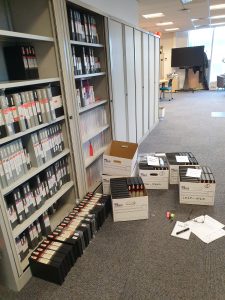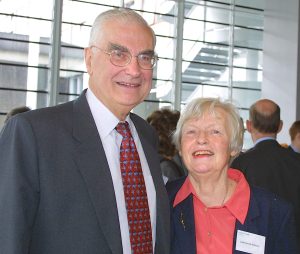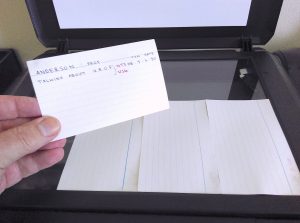 I started the Imperial College Videotape Archive (not this Blog) way back in August 1979. This was when we had just moved over into colour, and also recording on the U-Matic videotape format. Since that time many hundreds of recordings, and therefore videotapes, have been collected into what is now the archive. This archive is not to be confused with the videotape archive of STOIC, these archives are not the same thing. Some early recordings can be seen in the photo over on the right, these are from early 1985 and includes the City & Guilds Centenary Week on 1089A.
I started the Imperial College Videotape Archive (not this Blog) way back in August 1979. This was when we had just moved over into colour, and also recording on the U-Matic videotape format. Since that time many hundreds of recordings, and therefore videotapes, have been collected into what is now the archive. This archive is not to be confused with the videotape archive of STOIC, these archives are not the same thing. Some early recordings can be seen in the photo over on the right, these are from early 1985 and includes the City & Guilds Centenary Week on 1089A.
 When it all started it was the archive of the Imperial College TV Studio, that changed into Media Services and finally Communications, which was the custodian of the collection until this month. In the first week of 2024 the entire videotape archive was boxed-up and is now ready to be shipped off, and into the hands of the college’s main Archive. This is also where STOIC’s archive is also maintained having been saved from (unbelievably) being put into a skip.
When it all started it was the archive of the Imperial College TV Studio, that changed into Media Services and finally Communications, which was the custodian of the collection until this month. In the first week of 2024 the entire videotape archive was boxed-up and is now ready to be shipped off, and into the hands of the college’s main Archive. This is also where STOIC’s archive is also maintained having been saved from (unbelievably) being put into a skip.
 It was not a quick job either; along with Martin Sayers, it took over 6 hours to carefully pack the tapes, make a note of which tapes are now in each box and also mark production numbers on the front of the boxes. This way we will know where to find any particular tape in the future. In the photo over on the right, we had only just started to sort out and then pack the videotapes which we had removed from the shelves. In box number 2 for example you can see production numbers 1027 (September 1981) to 1045. These are all in the U-Matic format but we moved, over time, to Betacam and then DVCam, but there are a few other formats mixed in.
It was not a quick job either; along with Martin Sayers, it took over 6 hours to carefully pack the tapes, make a note of which tapes are now in each box and also mark production numbers on the front of the boxes. This way we will know where to find any particular tape in the future. In the photo over on the right, we had only just started to sort out and then pack the videotapes which we had removed from the shelves. In box number 2 for example you can see production numbers 1027 (September 1981) to 1045. These are all in the U-Matic format but we moved, over time, to Betacam and then DVCam, but there are a few other formats mixed in.
 So it’s finally goodbye to a large part of my life which is wrapped up in many different videotapes. Also, it’s a very large part of the life of Imperial College and its history. Captured on those videotapes are many things that I’ve featured in this blog: Linear Motors, Electrochromic Displays, the World’s First Calculator on a computer, the Centenary year of City & Guilds in 1985, the Imperial College Centenary in 2007, Rectors of Imperial College from Lord Penney onwards and many views of the campuses and departments that have changed forever. I also instigated the first ever recording of a Commemoration Day at the Royal Albert Hall. Following that, Martin and I recorded every Commemoration Day and Post Graduate Awards ceremony. These started to be made available on VHS tape, then DVD and finally put onto YouTube. Martin now carries this on with live YouTube steaming of the events.
So it’s finally goodbye to a large part of my life which is wrapped up in many different videotapes. Also, it’s a very large part of the life of Imperial College and its history. Captured on those videotapes are many things that I’ve featured in this blog: Linear Motors, Electrochromic Displays, the World’s First Calculator on a computer, the Centenary year of City & Guilds in 1985, the Imperial College Centenary in 2007, Rectors of Imperial College from Lord Penney onwards and many views of the campuses and departments that have changed forever. I also instigated the first ever recording of a Commemoration Day at the Royal Albert Hall. Following that, Martin and I recorded every Commemoration Day and Post Graduate Awards ceremony. These started to be made available on VHS tape, then DVD and finally put onto YouTube. Martin now carries this on with live YouTube steaming of the events.
Farewell, it’s been (and still is) nice rewinding you…
Colin Grimshaw January 2024
Read Archive on the move: 2024 in full
 The Rector prior to Sir Richard Sykes was Lord Ron Oxburgh. Like other videos of past Rectors in this series Lord Oxburgh is also reflecting on his time in that post. He was in conversation with Anne Barrett Archivist of Imperial College. We recorded the conversation in the college TV Studio in 2006, the year before Imperial’s centenary. Until now, only a few minutes of this recording were used and that was only on the centenary website.
The Rector prior to Sir Richard Sykes was Lord Ron Oxburgh. Like other videos of past Rectors in this series Lord Oxburgh is also reflecting on his time in that post. He was in conversation with Anne Barrett Archivist of Imperial College. We recorded the conversation in the college TV Studio in 2006, the year before Imperial’s centenary. Until now, only a few minutes of this recording were used and that was only on the centenary website.














